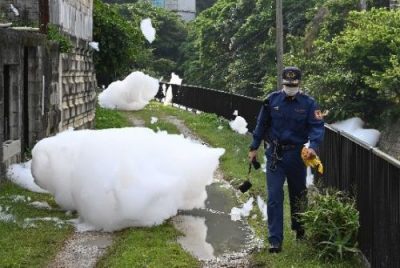Organic fluorine compound contamination detected at six times index value in Uchidomari River

Discharged on Futenma Air Station, foaming fire extinguishing agent scattered to a residential district and was photographed around 8:12 a.m. on April 11 in Ojana, Ginowan City (photograph provided by Takaya Kinra)
April 24, 2020 Ryukyu Shimpo
By Takaya Kinra
On April 10, in relation to the incident of organic fluorine compounds (PFAS) such as PFOS, which are suspected to be carcinogenic, being discharged from Futenma Air Station, the Ryukyu Shimpo requested that Associate Professor Koji Harada of Kyoto Univesity analyze samples collected from 5 rivers and other waterways in the vicinity on April 11-13 for organic fluorine compound content. The results of this analysis show that 247.2 nanograms (ng) of PFOS/PFOA (per liter) was detected in water collected from Uchidomari River in Ginowan City, which is six times the provisional index value of a total of 40 ng/L
underground water contamination determined by the U.S. military. Four sites from which water was collected were detected to contain high levels of organic fluorine compounds. High concentrations of organic fluorine compounds such as PFOA and PFHxS were detected, as well as PFOS which the U.S. military has declared is contained in a fire extinguishing agent.

In the United States, if levels exceed provisional index values formulated by the Environmental Protection Agency (EPA), the EPA recommends further investigations. This time, in each of the water samples in which levels exceed the index value, the PFOA value was higher than the PFOS value.
In general river water or the like, the total PFOS/PFOA content is about 10 ng/L. A panel of experts from the Ministry of the Environment’s Central Environmental Council has proposed 50 ng/L as a provisional index value, but the values detected at this time greatly exceed this value. Professor Harada pointed out, in regard to these results, “Environmental pollution from U.S. military bases is certainly rising”.
For this analysis, water samples were collected from 5 spots such as the surroundings of Uchidomari River and Makiminato fishing port in Urasoe City. The highest total level of PFOS/PFOA was 247.2 ng/L, collected at Uchidomari River on April 12. The next highest value was 144.0 ng/L in water collected from a pool of water along the same river, collected on April 11, which is still 3.6 times the provisional index.
At a point at which the river converges with a subterranean drain through which water from on the military base flows, a high level of 50.0 ng/L (collected April 13) was detected, meanwhile, water upstream from the confluence point had a lower value of 30.2 ng/L (collected April 12). Seawater from Makiminato fishing port (collected on April 12) contained 41.0 ng/L, exceeding the provisional index value.
PFOS/PFOA
PFOS/PFOA are varieties of organic fluorine compounds. As suspected carcinogens, the production and use of PFOS is internationally restricted by the Stockholm Convention on Persistent Organic Pollutants (POPs Treaty). In Japan, except for in some cases, the use and production of these is generally prohibited. External organizations of the World Health Organization (WHO) have indicated PFOA as a substance liable to be carcinogenic, and chemical manufacturers are voluntarily abolishing use of PFOA. As a substance, it is highly stable, so it does not substantially decompose in the environment, and poses the danger of accumulating in living organisms.
・・・・・・・・・・・・・・・・・・・・・・・・
In response to an incident on April 10 during which a foaming fire extinguishing agent was discharged on Futenma Air Station, on April 11 around 9:00 a.m. the Ryukyu Shimpo sampled a pool of water, which sits alongside Uchidomari River (Hiyara River) in Ginowan City and to which large quantities of foam clung. At around 7:00 p.m. on April 12 a water sample was collected at a point about 50 meters upstream from a confluence point at which Uchidomari River converges with a subterranean drain through which water from on the military base flows. After 7:00 p.m., water was sampled from Uchidomari River, after the large quantities of foam from April 11 had scattered. At about 7:30 on April 12 seawater was collected from Makiminato fishing port. At about 7:00 p.m. on April 13, water was collected about 100 meters upstream from from a confluence point at which Uchidomari River converges with the subterranean drain. The collected water samples were sent to Kyoto University on April 16 to be analyzed by Associate Professor Koji Harada, as requested. The results were released on April 22. These results showed organic fluorine compound PFOS and similar substances, and upon investigation it appears that 13 varieties of organic fluorine compounds are included in the foaming fire extinguishing agent.
(English translation by T&CT and Erin Jones)
Previous Article:Nanbu Medical Center workers fighting COVID-19 post ‘thank you’ sign in windows
Next Article:Mystical, endangered orchid blooms in Nago City
[Similar Articles]
- JASDF finds 128 times national guideline levels of chemicals like PFOS in water on Naha Base
- High levels of PFOS detected in Kin Town, the highest level at site adjacent to US base
- Record high concentrations of PFAS detected in groundwater around Kadena Air Base
- PFAS levels exceed the national provisional guideline value at two water sources in Kin Town
- Detection of PFOS in drinking water leads to request for access onto US base compounds
 Webcam(Kokusai Street)
Webcam(Kokusai Street)


